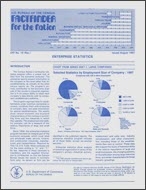
An official website of the United States government
Here’s how you know
Official websites use .gov
A .gov website belongs to an official government organization in the United States.
Secure .gov websites use HTTPS
A lock (
) or https:// means you’ve safely connected to the .gov website. Share sensitive information only on official, secure websites.
-
//
- Census.gov /
- Publications /
- Factfinder for the Nation: Enterprise Statistics
Factfinder for the Nation: Enterprise Statistics
Factfinder for the Nation: Enterprise Statistics
Introduction
The Census Bureau’s enterprise statistics program offers a unique look at data from the economic censuses. The enterprise reports present information at the company or firm level rather than for establishments, as virtually all the other census reports do. The program’s primary contribution to the economic analysis of the country’s industrial organization is in its unique ability to relate each company’s data directly with its component establishment statistics.
The program regroups data for establishments under common ownership or control, combines them with enterprise or company data, and adds information for special establishments. The results show various economic and structural characteristics of the owning or controlling firms and the industries in which they operate. The employment size table, for example, can be a measure of the relative importance of large and small firms.
Since 1954, the enterprise statistics program has been an integral part of the economic censuses, which cover retail and wholesale trade; service, mineral, and construction industries; manufactures; and transportation. Required by Title 13, U.S. Code, these censuses are for the years ending in “2” and “7.” By law, response to these censuses is mandatory and the supplied information is confidential, so that the Census Bureau issues the results in summary form only; no person or firm can be identified in the published reports. The enterprise statistics program includes all of these fields, except tax-exempt services.1
Enterprise statistics allow analysis of industrial organization in terms of the company’s primary industrial activity, employment and sales size, industry concentration, and other characteristics, including those of the establishments they own or control. These data also support the study of historical shifts in the relative importance of large and small businesses, the changing patterns of diversification among large industrial firms, and similar characteristics by broad industry groupings.
The program also yields separate data about auxiliary establishments – those where employees are engaged primarily in support services for the same company’s operating establishments (e.g., its mines, factories, or retail stores) rather than for the general public or for other business firms. Most auxiliary establishments perform administrative functions, like management, accounting, or purchasing, but others might have such activities as central warehousing for the company’s merchandise; research, development, and testing laboratories of manufacturing firms; and electronic data processing. (The census definition for an auxiliary does not include sales branches and sales offices of manufacturing and mining companies; these are classified under wholesale trade.)
__________
1 The 1982 program included some data on agriculture, but had none on transportation.
Others in Series
Publication
Publication
Publication
Share
Related Information
Some content on this site is available in several different electronic formats. Some of the files may require a plug-in or additional software to view.
 Yes
Yes
 No
NoComments or suggestions?


Top

